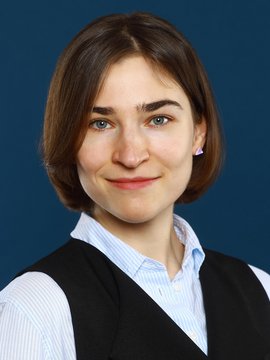Dr. Tatiana Savranskaia

Research Interests:
Paleomagnetic field
- Acquisition of Earth's Magnetic field Intensity by sedimentary records
- The Reliability of magnetic minerals (Relative Paleointensity) to record the magnetic field variations
- Environmental modulation of Relative Paleointensity records
Cosmogneic Isotopes
- The Reliability ofcosmogenic Isotope 10Be to record the magnetic field variations
- Environmental modulation of sedimentary cosmogenic Isotope records
Post-depositional processes in the marine environment
- Post-depositional processes affecting sedimentary records
- Sediments bioturbation
Career:
Feb 2022 - Currently Postdoc, Humboldt Research Fellowship, GFZ, Potsdam, Germany
2017-2020 PhD candidate, ERC project EDIFICE (PI: Jean-Pierre Valet ), Institut de Physique du Globe de Paris - Université de Paris, France
2016 Technical assistant. ERC project EDIFICE (PI: Jean-Pierre Valet ), Institut de Physique du Globe de Paris-Université de Paris,France
2015 Teaching assistant of practical and theoretical course "Fundamentals of Reservoir Engineering", Tyumen State Oil and Gas University, Tyumen, Russia
2012-2013 Intern-geologist in the department of West-Siberian exploration works, V.I. Shpilman Research and Analytical Centre for the Rational Use of the Subsoil, Tyumen, Russia.
Education:
2017-2020 Ph.D. in Geophysics, Institut de Physique du Globe de Paris - Université de Paris, France
2014-2015 M.sc. in Reservoir Geosciences and Engineering, L'institut Français du pétrole (IFP School), Rueil - Malmaison, France & Tyumen State Oil and Gas University, Tyumen, Russia (Double master degree)
2008-2013 Min.Eng. in Geology of Oil and Gas, Tyumen State Oil and Gas University, Tyumen, Russia
Projects:
2022 Postdoctoral Humboldt Research Fellowship. Assessment of sedimentary 10Be data reliability for global geomagnetic field models.
Records of paleomagnetic field intensity variations are of paramount importance for understanding the evolution and driving mechanisms sustaining the geodynamo. One of the few means of obtaining continuous reconstructions of this evolution relies on sedimentary records. They provide an important tool for magnetostratigraphy, and most importantly, allow us to trace the directional and intensity changes in the past. Marine sedimentary sequences record the paleomagnetic field history by two independent mechanisms: the alignment of magnetic particles, which underlies continuous records of relative paleointensity (RPI), and the archivation of cosmogenic isotopes, in particular 10Be, whose production by cosmic ray spallation is modulated by the screening action of the dipole component of the Earth’s field.
Additional insight on the change of the Earth's interior could be gained with global data-based models. The principal sources of paleomagnetic data used for global field modelling are natural remanent magnetisation of sediments, volcanic rocks and archeomagnetic fragments. The records of cosmogenic 10Be provide an independent source of data, unaffected by rock magnetic alterations, and could be complementary integrated into the global field models, but nowadays global magnetic field models do not include beryllium records that directly influence the Gauss coefficient. Implementation of cosmogenic 10Be into global magnetic field models should be done with caution, due to persisting environmental contribution into the signal. The main objectives of this project are to filter the misleading information by the virtue of developed 10Be scaling routine and to assign the uncertainty related to this method. Accurate error estimations are necessary for robust geomagnetic field modelling and recovery of unhampered amplitude of magnetic field changes. These steps will allow us to integrate the records of cosmogenic 10Be into the global field models and to answer the questions related to global or regional simultaneous occurrence of geomagnetic excursions and data distribution influence on the models.
Awards:
2021 - Humboldt Research Fellowship, GFZ, Potsdam, Germany
2019 - International mobility grant for research visit at ZAMG (Vienna, Austria) during 2 months, issued by Doctoral School ED560, Institut de Physique du Globe de Paris - Université de Paris, France
2018 - Fellow of IRM institute : Summer School in Rock Magnetisme (SSRM), Institute for Rock Magnetism, University of Minnesota, USA
2017 - Winner of Outstanding student paper award competition (OSPA), AGU - 2017 fall meeting New Orleans, USA


